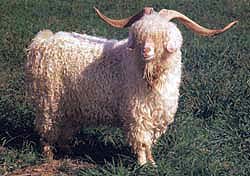
Mohair is the lustrous and strong hair of the Angora goat. Often labeled "the diamond fiber" it's distinct properties have made it a highly desired fiber for clothing and home furnishings. Angora goats evolved on the Anatolian Plains of Turkey and goats were highly regarded and jealously protected from exportation until the sixteenth century when the Angora goat was introduced into Spain and France. However, a small flock of seven does and two bucks were introduced to the United States in 1849. Since then the USA has developed into one of the two largest mohair producing nations in the world with an annual production of two million pounds. The mild dry climate of SW Texas is the primary mohair region producing 90% of our total USA mohair from a herd of 200,000 goats.
The spinning process is the twisting of the mohair into single yarns. When two or more of these single yarns are twisted together, they form "ply yarns", which are stronger than singles. For cinch making, generally, we use 8-ply cord for the cinch body, and 2-ply yarn for designs. 8-ply mohair cord averages 1/4 inch width.
Prior to the development of synthetic fibers such as rayon, which doesn't "breathe", mohair was the obvious traditional choice for horse cinches. As the American consumer becomes more aware of environmental and quality issues, today's horseman have rediscovered the benefits of mohair for cinches, breast collars, mecates, and reins. Today's consumer seeks quality at reasonable price and products that will last and perform. Hand crafted mohair tack meets these demands.
Benefits of Mohair and its Care
The spinning process is the twisting of the mohair into single yarns. When two or more of these single yarns are twisted together, they form "ply yarns", which are stronger than singles. For cinch making, generally, we use 8-ply cord for the cinch body, and 2-ply yarn for designs. 8-ply mohair cord averages 1/4 inch width.
Prior to the development of synthetic fibers such as rayon, which doesn't "breathe", mohair was the obvious traditional choice for horse cinches. As the American consumer becomes more aware of environmental and quality issues, today's horseman have rediscovered the benefits of mohair for cinches, breast collars, mecates, and reins. Today's consumer seeks quality at reasonable price and products that will last and perform. Hand crafted mohair tack meets these demands.
Benefits of Mohair and its Care
- Only American 100% Mohair is used in our Copper Canyon Cinches.
- Mohair is a natural fiber that doesn't weaken or stretch when it gets wet, it's stronger than wool, and it's said that Mohair is stronger than steel in comparable diameters. It is long wearing, and is naturally soft.
- Mohair wicks moisture and sweat, helping to keep the horse's girth area cool and dry resulting in comfort.
- Mohair doesn't weaken or stretch when it gets wet, resulting in a long lasting product.
- Mohair is resilient, it does not easily crush or become matted.
- Our horses seem to enjoy the smell and comfort of mohair. Mohair cinches are very beneficial to "cinchy or galled" horses
- Mohair yarns & fabrics soft luxurious feel with a rich luster and shine.
- Because mohair is composed of protein it has a high affinity for color tint dyes being absorbed completely through the fiber, giving rich and long lasting hues that have an unmatched clarity and a halo-like glow. Custom color dying will be available soon.
 RSS Feed
RSS Feed